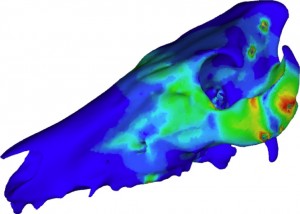Scientific publishing is entering a new era, with digital content becoming more and more important in a world where data is openly and freely shared. In palaeontology, we’re not being left behind. Along with this shift, 3D fossils are adding a new breadth to the field, both in a scientific and educational context. A great example is the British Geological Survey’s immense 3D fossil project.
I thought it might be a nice idea to draw attention to a new article by Stephan Lautenschlager of the University of Bristol, discussing the role that 3D palaeontology has to play in the current publishing world, as well as ways of implementing it. He’s been cool enough to make the article open access (see link at the bottom), so I’d recommend heading over to check it out.
It’s quite a neat article, discussing the ways in which a 3D model can be represented in the typically 2D pdf format of publishers’ choice, in order to increase the accessibility of science. This could be a wicked new way of utilising a novel approach towards science communication, especially if it goes beyond the actual articles themselves and can become embedded within additional outreach efforts. (maybe even blogs?)
With tools like PDF3D and ReadCube with its interactive pdf function, this could very much be a viable and common practice for future palaeo-publications. A recent paper by Andy Farke and colleagues on a baby hadrosaur specimen came close, with all the 3D freely available for download.

Three-dimensional Finite-Element Analysis model of the domestic pig, with the different colours representing different strains (Lautenschlager, 2013)
Some notes:
Note: http://virtualexplorer.com.au/ Looks pretty advanced for this kind of thing. Thanks to Christoph Gruetzner for the tip.
Note 2: http://jcb-dataviewer.rupress.org/ The Journal of Cell Biology appear to use the Open Microscopy Platform (http://www.openmicroscopy.org/site). Thanks to Miriam Matamales for the tip.
Note 3: Elsevier *shiver* also have an online publication that integrates 3D models, called Digital Applications in Archaeology and Cultural Heritage. Check out one of their open access articles – it’s actually pretty neat! Thanks Ilaria Meliconi for the tip.
Note 4: How could I forget! Palaeontologia Electronica is a fully digital, and open access publication. And yeah, it allows integration of 3D models with the online publications. Thanks Edward Price for the tip.
Reference:
Lautenschlager (2013) Palaeontology in the third dimension: a comprehensive guide for the integration of three-dimensional content in publications, Palaontologische Zeitschrift, DOI: 10.1007/s12542-013-0184-2 (OA link)


Pingback: Three-dimensions of palaeontological awesomenes...